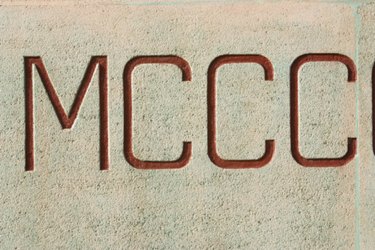Things You'll Need
Pen or pencil
Paper

The Roman Empire dissolved over 1500 years ago but many of its contributions to Western Civilization can still be seen on a daily basis, whether in government, architecture or language. One of those developments was the numerical system known as Roman numerals. Today, Roman numerals can be found on government buildings and public monuments, as well as on US currency, clocks, as labels for book chapters and movie sequels. While they may seem like a strange conglomeration of letters, Roman numerals are actually easy to read and write. With just a little reading and practice, you will be able to write any date in history in Roman numerals, including your birthday or the birthday of a friend or loved one. Not only is it fun, it makes any date look more sophisticated and official.
Familiarize Yourself with the Roman Numeral System
Step 1
Begin by learning the numbers of the Roman numeral system. Unlike Arabic numerals, which are the numbers we know as 1-10, Roman numerals are represented as letters, and there are only seven of them. I equals 1 V equals 5 X equals 10 L equals 50 C equals 100 D equals 500 M equals 1000
Video of the Day
Step 2
Roman numbers begin with I, which equals the number 1. Since there is no individual Roman numeral for the number 2, it's represented by the combination of 2 symbols for the number 1, or II (I+I=II). This guideline caries throughout the Roman number system as you'll see as you continue counting. III=3 (1+1+1) IV=4 (1 before 5=4) V=5 VI=6 (5+1) VII=7 (5+2) VIII=8 (5+3=8) IX=9 (1 before 10=9) X=10
A number can only be repeated three times, as in the case of the Roman numeral for 8, VIII, which features the symbol for 5 (V) and 3 symbols for the number 1(I). This is so that the number is still manageable. Just think back to the Roman times when so much was carved in stone or painstakingly written on paper! Streamlining numbers saved a lot of time and effort.
Step 3
When reading Roman numerals, add the numbers together if the value of the first number is larger than the second number. Take for example, VII, the Roman number for 7. Since the first number, V, equals 5, and the second and third numbers equal the number 1, the three numbers are added together. 5+1+1 = 7, or VII.
Step 4
Subtract the value of the first number from the second number if the value of the first number is smaller than the second. For example, IX, the Roman numeral for 9, features the symbols for 1 and 10, but since the first letter is smaller it's subtracted from the second letter. Thus it reads 1 before 10 which equals the number 9, or IX in Roman numeral.
Step 5
Remember that when it comes to dates, Roman numerals denote only years, not months or days. Still, for the sake of your birthday or a friend's birthday, you can write the date by using the Roman numeral for the month, date and year of the birthday separated by backslashes. For example, 09/20/1981 would be written IX/XX/MCMLXXXI. Other ways the birthday could be written are September 20, MCMLXXXI or even September XX, MCMLXXXI.
Video of the Day